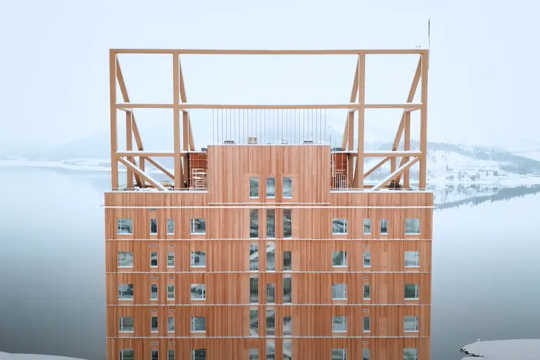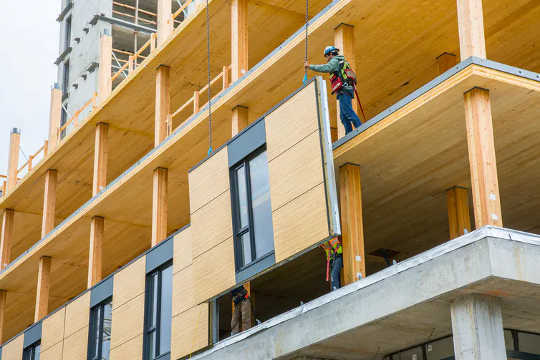
The Mjøstårnet, an 18-storey mixed-use building constructed with engineered wood, overlooks Norway’s largest lake, in Brumunddal. (Woodify/YouTube)
All over the world, architects and engineers are crafting cutting-edge skyscrapers from one of the most renewable and sustainable materials available to humanity — wood.
For the time being, the tallest wooden building in the world is the Mjøstårnet, an 18-storey building north of Oslo that houses offices, hotel rooms and apartments, and stands just over 85 metres in height.
Canada has several tall wooden towers, including Brock Commons at the University of British Columbia (18 storeys; 58 metres) and the Origine eco-condo development in Québec City (13 storeys). A number of other projects, such as the 10-storey Arbour at George Brown College’s Waterfront Campus, are under development.
For some, wood may seem an archaic and even dangerous choice for tall building construction compared to modern alternatives like concrete, steel and glass. But as emissions associated with tall buildings continue to rise, governments at all levels are looking for low-carbon, low-energy alternatives.
In Canada, buildings account for 12.7 per cent of national greenhouse gas emissions. Globally, buildings lead to 40 per cent of total emissions. For Canada, a country with abundant wood resources, investing in new tall wooden building construction is an opportunity for sustainable economic growth — but challenges remain.
Not your average log cabin
Today’s tall wooden buildings are different from the two-by-four wood framing usually seen in single-family homes or two- to four-storey condominium structures.
So-called “mass timber” construction is derived from old techniques of post-and-beam construction, but uses advanced technologies, including cross-laminated timbers (CLT) and laminated veneer lumber (LVL), which feature layers of wood bonded with adhesives and produced as either beams or panels. Some concrete and steel may be used around elevator shafts or stairwells in mass timber construction, but floors and beams may be made entirely of wood.
Structural wood products like CLT have a number of advantages in tall wooden building consruction: they are lighter than conventional materials, require less energy to make than either steel or concrete (and thus produce lower emissions), and can sequester carbon.
{vembed Y=zY0vFOZ6-us}
The Mjösa Tower (Mjøstårnet) in Brumunddal, Norway, is — for now — the world’s tallest wooden building.
Their relative lightness makes it possible to assemble floor and wall sections off-site and ship them to the build site, significantly reducing the amount of building time required. For example, the on-site construction for the Origine project in Québec City was completed in only four months. Adopting tall wooden construction could greatly reduce the amount of disruption — dust, noise and traffic disruptions, for example - that construction brings to the urban landscape.
Building better, faster and greener
Prefabrication also means that building structures can be designed to maximize energy efficiency since individual components can be built precisely in a factory, minimizing errors and ensuring that measurements are exact.
Tall wooden buildings store carbon, preventing it from entering the atmosphere by sequestering it in the building for decades. In contrast, buildings made of steel and concrete generate large amounts of carbon emissions per tonne of material produced.
 UBC’s Brock Commons floor structure contains cross-laminated timber (CLT) panels supported on glue-laminated timber (glulam) columns. The prefabricated panels shortened the on-site construction time. (KK Law/Naturally Wood/UBC), CC BY-NC
UBC’s Brock Commons floor structure contains cross-laminated timber (CLT) panels supported on glue-laminated timber (glulam) columns. The prefabricated panels shortened the on-site construction time. (KK Law/Naturally Wood/UBC), CC BY-NC
For example, the Brock Commons at UBC sequesters an estimated 1,753 tonnes of CO2. Research suggests that tall wooden buildings have a 20 per cent reduction in both their carbon and energy footprints.
These types of buildings could be important in helping Canada, and many other countries around the world, achieve net zero performance measures related to energy efficiency and overall carbon emissions that will be required in meeting future climate goals.
Clear-cut solution?
The perception remains that tall wooden buildings less resistant to fire than a typical concrete and steel building. But the designs of these buildings meet stringent fire codes.
The U.S. National Fire Protection Association, in collaboration with Canada’s National Research Council, recently delivered a series of reports on the fire risk associated with tall wooden buildings, with particular focus on the behaviour of cross-laminated timbers or laminated veneer lumber.
Overall, their findings showed that tall wooden buildings can meet the minimum two-hour fire protection ratings required by most jurisdictions, if proper fireproofing materials and sprinklers are incorporated into the design. In the event of fire, the design minimizes danger in early stages, allowing inhabitants to escape and the fire to be brought under control.
Another challenge tall wooden buildings face is the environmental impact they may have on forests. If wood is not sourced from sustainable, responsibly managed forests, any benefit derived from the building itself would be offset by increased deforestation and habitat loss.
A number of tools, like the certification programs run by the Forest Stewardship Council or the Programme for the Endorsement of Wood Certification provide important third-party verification that forest harvests are done within a sustainable management regime; these schemes are constantly being reviewed to consider all aspects of forest sustainability, including carbon depletion in forest soils and impacts biodiversity. As tall wooden buildings take off, it is critical that the wood used in construction be sourced in an increasingly sustainable fashion.
Tall wooden buildings are likely to play an increasingly important role in our carbon mitigation strategies. Recent work suggests that shifting to wooden construction could act as an ever-increasing carbon sink, allowing more and more carbon to be sequestered safely in useful applications.
The crown for the tallest wood building will be hard to keep. In Tokyo, a proposal for a 350-metre tall, 70-storey building is currently vying for the title.
As architects, engineers and tradespeople become comfortable with these materials, tall wooden buildings will increasingly become a part of the urban landscape around the world.![]()
About the Author
Warren Mabee, Director, Queen's Institute for Energy and Environmental Policy, Queen's University, Ontario
This article is republished from The Conversation under a Creative Commons license. Read the original article.
Related Books
Drawdown: The Most Comprehensive Plan Ever Proposed to Reverse Global Warming
by Paul Hawken and Tom Steyer In the face of widespread fear and apathy, an international coalition of researchers, professionals, and scientists have come together to offer a set of realistic and bold solutions to climate change. One hundred techniques and practices are described here—some are well known; some you may have never heard of. They range from clean energy to educating girls in lower-income countries to land use practices that pull carbon out of the air. The solutions exist, are economically viable, and communities throughout the world are currently enacting them with skill and determination. Available On Amazon
In the face of widespread fear and apathy, an international coalition of researchers, professionals, and scientists have come together to offer a set of realistic and bold solutions to climate change. One hundred techniques and practices are described here—some are well known; some you may have never heard of. They range from clean energy to educating girls in lower-income countries to land use practices that pull carbon out of the air. The solutions exist, are economically viable, and communities throughout the world are currently enacting them with skill and determination. Available On Amazon
Designing Climate Solutions: A Policy Guide for Low-Carbon Energy
by Hal Harvey, Robbie Orvis, Jeffrey Rissman With the effects of climate change already upon us, the need to cut global greenhouse gas emissions is nothing less than urgent. It’s a daunting challenge, but the technologies and strategies to meet it exist today. A small set of energy policies, designed and implemented well, can put us on the path to a low carbon future. Energy systems are large and complex, so energy policy must be focused and cost-effective. One-size-fits-all approaches simply won’t get the job done. Policymakers need a clear, comprehensive resource that outlines the energy policies that will have the biggest impact on our climate future, and describes how to design these policies well. Available On Amazon
With the effects of climate change already upon us, the need to cut global greenhouse gas emissions is nothing less than urgent. It’s a daunting challenge, but the technologies and strategies to meet it exist today. A small set of energy policies, designed and implemented well, can put us on the path to a low carbon future. Energy systems are large and complex, so energy policy must be focused and cost-effective. One-size-fits-all approaches simply won’t get the job done. Policymakers need a clear, comprehensive resource that outlines the energy policies that will have the biggest impact on our climate future, and describes how to design these policies well. Available On Amazon
This Changes Everything: Capitalism vs. The Climate
by Naomi Klein In This Changes Everything Naomi Klein argues that climate change isn’t just another issue to be neatly filed between taxes and health care. It’s an alarm that calls us to fix an economic system that is already failing us in many ways. Klein meticulously builds the case for how massively reducing our greenhouse emissions is our best chance to simultaneously reduce gaping inequalities, re-imagine our broken democracies, and rebuild our gutted local economies. She exposes the ideological desperation of the climate-change deniers, the messianic delusions of the would-be geoengineers, and the tragic defeatism of too many mainstream green initiatives. And she demonstrates precisely why the market has not—and cannot—fix the climate crisis but will instead make things worse, with ever more extreme and ecologically damaging extraction methods, accompanied by rampant disaster capitalism. Available On Amazon
In This Changes Everything Naomi Klein argues that climate change isn’t just another issue to be neatly filed between taxes and health care. It’s an alarm that calls us to fix an economic system that is already failing us in many ways. Klein meticulously builds the case for how massively reducing our greenhouse emissions is our best chance to simultaneously reduce gaping inequalities, re-imagine our broken democracies, and rebuild our gutted local economies. She exposes the ideological desperation of the climate-change deniers, the messianic delusions of the would-be geoengineers, and the tragic defeatism of too many mainstream green initiatives. And she demonstrates precisely why the market has not—and cannot—fix the climate crisis but will instead make things worse, with ever more extreme and ecologically damaging extraction methods, accompanied by rampant disaster capitalism. Available On Amazon
From The Publisher:
Purchases on Amazon go to defray the cost of bringing you InnerSelf.comelf.com, MightyNatural.com, and ClimateImpactNews.com at no cost and without advertisers that track your browsing habits. Even if you click on a link but don't buy these selected products, anything else you buy in that same visit on Amazon pays us a small commission. There is no additional cost to you, so please contribute to the effort. You can also use this link to use to Amazon at any time so you can help support our efforts.























